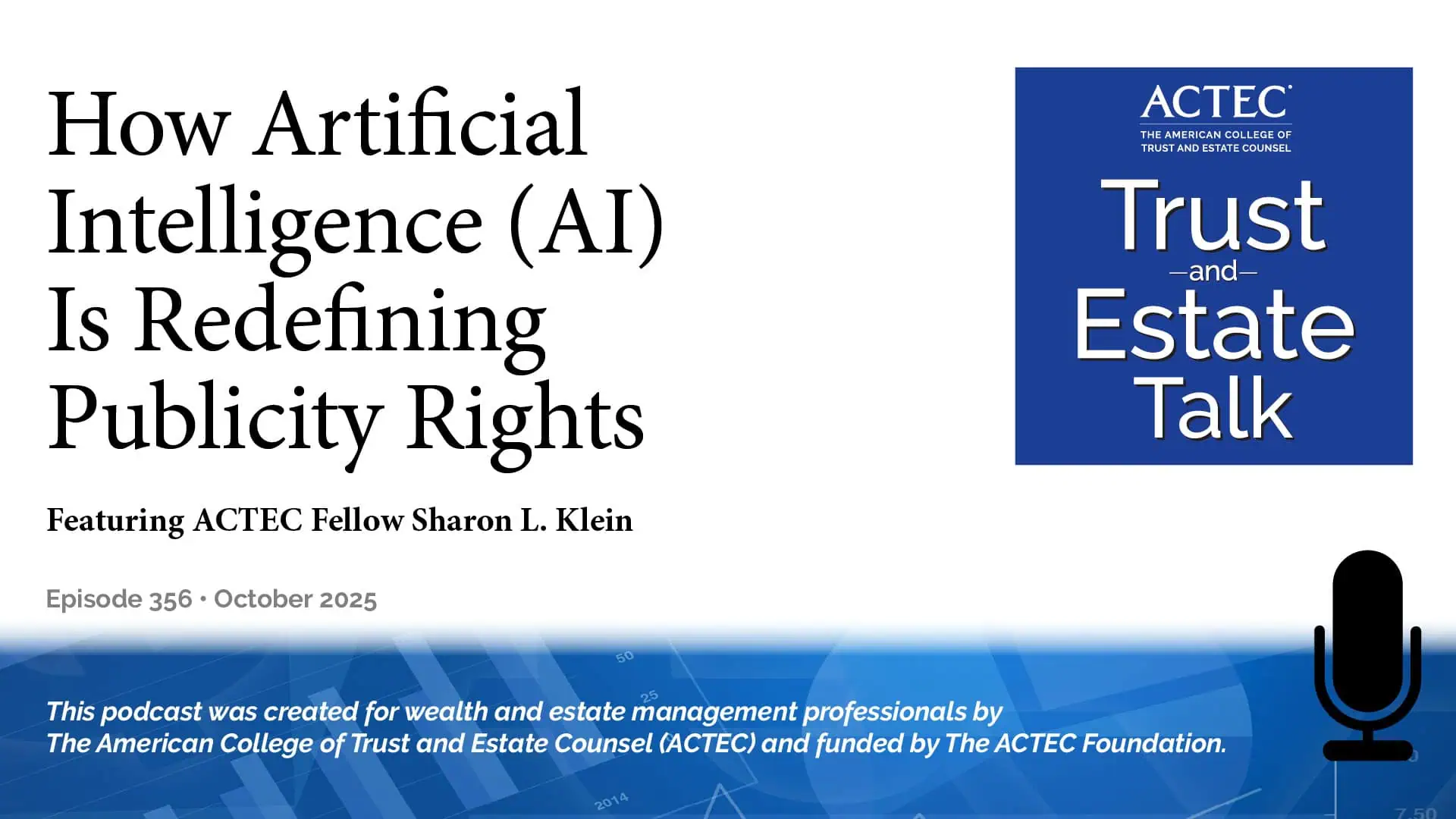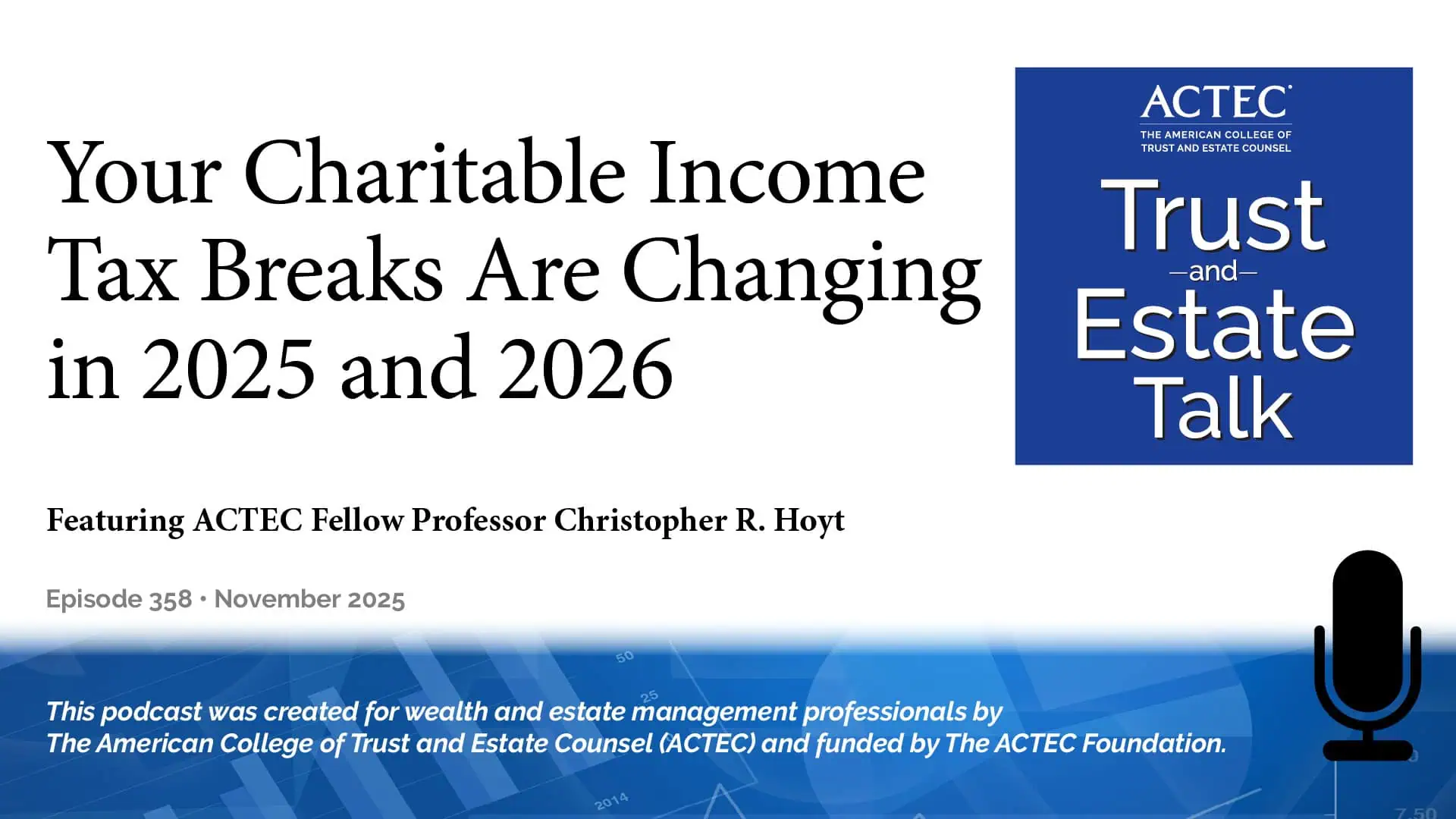How Artificial Intelligence (AI) Is Redefining Publicity Rights
“How Artificial Intelligence (AI) Is Redefining Publicity Rights,” that’s the subject of today’s ACTEC Trust and Estate Talk.
Transcript/Show Notes
This is ACTEC Fellow Travis Hayes of Naples, Florida.
How Artificial Intelligence Is Reshaping Publicity Rights
Today’s podcast dives into a topic that is exploding across headlines and courtrooms alike. From digital avatars to voice cloning and AI-generated influencers, we’re entering a new era where likeness, image, and identity can be replicated or even invented by machines. But what happens when your face or voice is used without your consent? What rights do individuals, celebrities, and everyday creators have over their digital selves?
ACTEC Fellow Sharon Klein of New York City joins us today to unpack the evolving legal landscape of publicity rights, the challenges posed by deepfakes and generative AI, and how courts, lawmakers, and content platforms are starting to respond. Welcome, Sharon.
Sharon Klein: Thanks so much, Travis. It’s a pleasure to be here. And I’m delighted to speak to you today about how artificial intelligence is redefining publicity rights.
Understanding the Right of Publicity and Its Legal Patchwork
So let’s start off by defining the right of publicity. The right of publicity in a nutshell is a person’s right to control and profit from the commercial use of their name, image, and likeness (NIL) and to prevent others from exploiting their persona for commercial gain. The post-mortem right of publicity, as its name implies, extends the right of publicity beyond an individual’s lifetime and allows an executor or an heir to enforce the protections that the law provides. The right of publicity and the post-mortem right of publicity are determined by state law, either through statute or case law. And because the state treatment of these rights is not uniform, what we’ve ended up with is a patchwork of different laws across the country.
And the issue we have today is that as we plan for and value these rights, we’re already seeing technology that would have been unimaginable even a couple of years ago, including entirely new categories of uses, such as digital replicas. And we have to grapple with planning for and valuing these rights, the uses of which may explode in ways even today we’re currently unable to predict.
The Challenge of Digital Replicas and Immortality
Technology, like the ability to create digital replicas, creates new challenges because with a digital replica – people never die, they’re immortal. And the rights of publicity laws in many states have been in effect for decades. They were enacted when today’s technology was inconceivable. So, what does all that mean? It means that the current state of the law is antiquated in light of the new technologies that really enable unprecedented exploitation of likeness, and that applies both during lifetime and after death. What I thought would be helpful would be to look at three case studies to illustrate the issues.
Case Study 1: ABBA and the Rise of the ABBAtars
And the first case study involves the band ABBA, a very popular band in the 1970s and early 1980s. And there’s currently a revolutionary concert experience now playing in London. It’s a specially designed unique theatre using digital avatars. And for the band ABBA, the avatars are called ABBAtars, cute. The concerts use motion capture technology to create virtual ABBA performances with these ABBAtars. And the band members appear as they looked in 1979 when they were in their 20s.
I personally went to one of these concerts and to say that the ABBAtars were holograms does not even begin to do it justice. The ABBA band – who, by the way, are all nearly 80 years old – looked as they did when they were 25. And they sang to me right before my very eyes and it was spectacular. Now the budget for this concert experience was reportedly $175 million, which makes it the most expensive live music experience in history. But listen to this, through 2024, it’s reported to have contributed $1.7 billion to the London economy. So big bucks are certainly at stake here.
And the legal framework in this case was that there was full consent and participation from all the ABBA band members. But, of course, there’s huge potential to create posthumous performance rights, because although the ABBA band members all happen to be alive, they needn’t be for these concerts to continue. We have the technology to reincarnate deceased performers.
Case Study 2: Voice Cloning – From Al Michaels to George Carlin
The second case study I want to talk to about involves Al Michaels, the famous sports commentator. NBC used AI-generated versions of Al Michaels’ voice for personalized Olympic recaps during the 2024 Summer Olympics in Paris. The technology was a high-quality AI voice recreation trained on Al’s past NBC appearances. And the AI voice could greet viewers by name and provide customized content. Al Michaels’ initial reaction was very skeptical that they could pull this off. But he himself called the end result “astonishing and amazing.” The legal framework here also was authorized use with NBC compensation to Al Michaels. And that demonstrates voice cloning with the consent of a living person.
But of course, there is also the potential to create posthumous voice cloning, which happened in the estate of comedian George Carlin, who died in 2008. His estate filed suit against a podcaster who used an AI-generated replica of Carlin’s voice to create a podcast titled “George Carlin: I’m Glad I’m Dead.” The podcaster later agreed to take down the podcast permanently and refrain from using Carlin’s image, voice, or likeness without the express approval of the estate. And this case happened in California. And on the heels of this case, California enacted legislation in 2024 which bans the use of digital replicas of deceased performers without estate consent. So those first two case studies involved AI with consent.
Case Study 3: Jack Nicklaus and the Battle Over Brand Ownership
The third case study I want to talk to you about involves a different set of facts. The third case involved the famous golfer Jack Nicklaus and it tackles the unprecedented question of who owns your brand. In other words, if a celebrity sells their image, are they unwittingly ceding control over their identity? And what happened in this case is that Jack Nicklaus sold his name, image, and likeness to the Nicklaus Companies in 2007 for $145 million. It was reported to be part of a broader estate plan to cash in on his name to give $20 million to each of his five children and some of the money to charity. However, the Nicklaus Companies claimed exclusive ownership rights to Jack Nicklaus’ name, image, and likeness, including their alleged right to create AI replicas of Jack to use as they determined. And they claimed Jack Nicklaus himself couldn’t independently engage in his own commercial activities using his own identity because they said, “we own your brand, Jack Nicklaus, we own you.“
Jack Nicklaus had a court victory in New York in March of 2025, when the New York court ruled that Nicklaus – in the particular contract he signed – did not unambiguously transfer his exclusive perpetual name, image, and likeness rights, which would in effect have constituted a permanent non-compete as against himself. The court held that he retained full control over his personal brand and endorsements. So, although Jack Nicklaus ultimately won that case, it really underscores the warning that it can be fraught with risk to allow someone else to use a celebrity’s identity. Because, once you cede your control, it’s very difficult to regulate how the celebrity is portrayed publicly. And I think the lesson we learn from that case is that name, image, and likeness needs to be carefully valued and planned for through estate planning documents, including trusts, through licensing arrangements or other mechanisms to achieve a client’s goals, to maximize the value for the heirs and to minimize the estate tax impact.
Valuing Publicity Rights in the Age of AI
Lessons from the Estate of Michael Jackson
Let’s move now to how AI impacts planning and valuation of publicity rights. In terms of valuation, in the high-profile 2021 case of the Estate of Michael Jackson — which involved California’s post-mortem right of publicity statute — that case really puts squarely in the spotlight the big dollars that are potentially at issue when you’re valuing name and likeness for estate tax purposes. And in that case, the estate originally valued Jackson’s image and likeness at about $2,000 on his estate tax return. The IRS initial valuation on order was slightly different, about $434 million, and that’s without even factoring the type of technology that we have today, including digital replicas that weren’t even around then. But in a stunning victory for the estate, the court determined that the value of Jackson’s image was around $4 million – the crux of the decision being the focus on valuing Jackson’s image at his date of death, at which point his reputation was in tatters because of the child abuse allegations against him.
In future cases, I think undoubtedly the potential of AI to add explosive additional value to post-mortem right of publicity values will almost certainly have to be considered, and that makes planning especially important.
Planning for Name, Image, and Likeness
So how do you plan for these publicity rights? In terms of the planning aspect, I think the most important takeaway is that you do need to plan for name, image, and likeness. When you look, for example, at the estate of the famous singer Prince, the entirety of Prince’s $300 million estate passed via Minnesota intestacy laws to his sister, a former crack cocaine addict and prostitute, and his five half-siblings. And apart from estate tax valuation issues, which the estate was embroiled in with the IRS for years, there was no management plan for his posthumous estate.
The first question in the planning process is a question for the client: What are the client’s wishes for the use of their name and likeness, both during their lifetime and after their death? Do they want their image commercialized after their death, not used at all, or used in a limited manner? We really need to understand a client’s wishes because the most important goal is to carry out the client’s vision of how their reputation should be preserved and used, especially now with AI in cases like the Jack Nicklaus case. What we’ve seen is that it’s about more than commercial exploitation. It’s about your legacy. It’s about how you want to be remembered. So the first question is to determine the client’s intent.
Once you’ve determined the client’s intent, the second question is: How can we structure the ownership of the right of publicity to integrate it into a client’s estate plan and maximize the value for heirs while minimizing the estate tax cost? And in terms of planning, I’m reminded of the old adage, “there’s nothing new under the sun” because the same techniques that have served us well in trying to reduce the value of other assets — like business assets, trying to slice and divide ownership among multiple structures to garner minority interest and lack of marketability discounts to minimize the state tax values — those same techniques might be just as applicable in this context too. Additionally, considering insurance to offset the increased value of the estate may merit consideration to provide liquidity.
Final Takeaways on AI and Publicity Rights
So just to sum up my final takeaways on this evolving area, we now have digital immortality. AI enables us the unprecedented ability to recreate both living and deceased individuals in perpetuity. In other words, people could live forever. We need to grapple with the vast state law variations and deal with the patchwork of different state publicity rights laws we have against the backdrop that technology is fast outpacing the law. Legal frameworks are struggling to keep up. They must evolve to address the new technological realities and having federal legislation would certainly be desirable to create consistent national standard. And federal legislation has been introduced, but it’s not yet passed, so we still do have to grapple with this patchwork of different state laws.
And, at the end of the day, I really think it’s about balancing innovation, the new technologies and the protection of the individual rights at issue. And the bottom line really is that I think today’s discussion highlights the importance of working with a qualified team of multidisciplinary advisors to incorporate the latest technological advancements and legal developments in lifetime and estate planning to best position clients and teams (would typically include trust and estate attorneys, intellectual property attorneys, investment advisors, and other professional advisors) who are all working together to integrate all these elements to come up with the best holistic plan for clients.
Travis Hayes: Thank you, Sharon, for discussing the groundbreaking topic of artificial intelligence’s effect on publicity rights and the evolving law affecting those rights.
You may also be interested in:
- The Ethical Use of Artificial Intelligence in Trust & Estate Law (Apr 2024)
- What Is Artificial Intelligence and the Impact on T&E Law in 2024 and Beyond? (Apr 2024)
- AI-Related Practice Management Considerations for Law Firms (Apr 2024)
- Government Regulation of Artificial Intelligence (Apr 2024)
A video to share with your clients:
What Is Artificial Intelligence and the Impact on T&E Law in 2024 and Beyond? (Apr 2024)
Latest ACTEC Trust and Estate Talk Podcasts
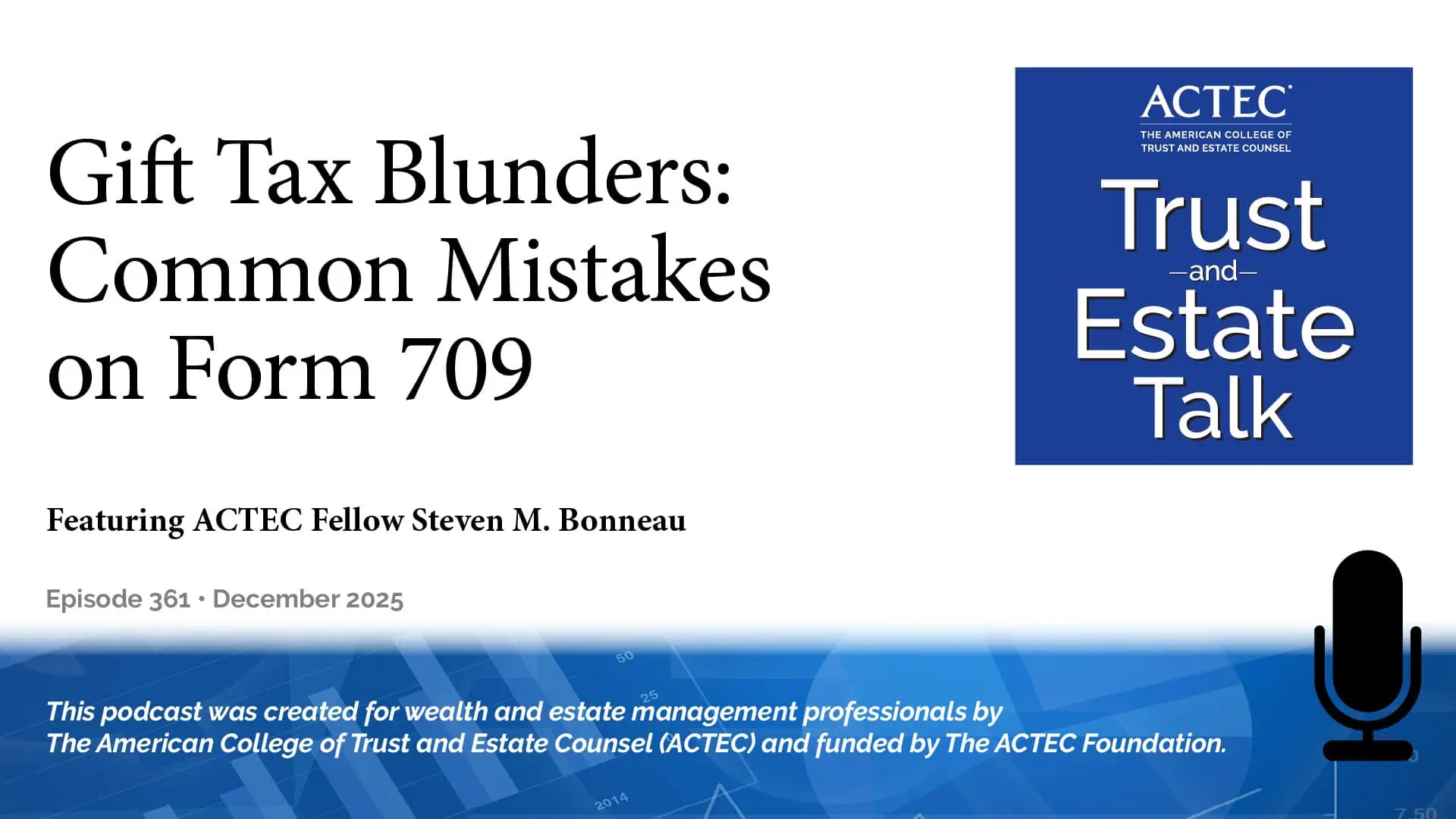
Gift Tax Blunders: Common Mistakes on Form 709
Common Form 709 mistakes can trigger costly GST and gift-tax consequences. ACTEC experts explain how to spot and fix DSUE, GST allocation, and gift-splitting errors.
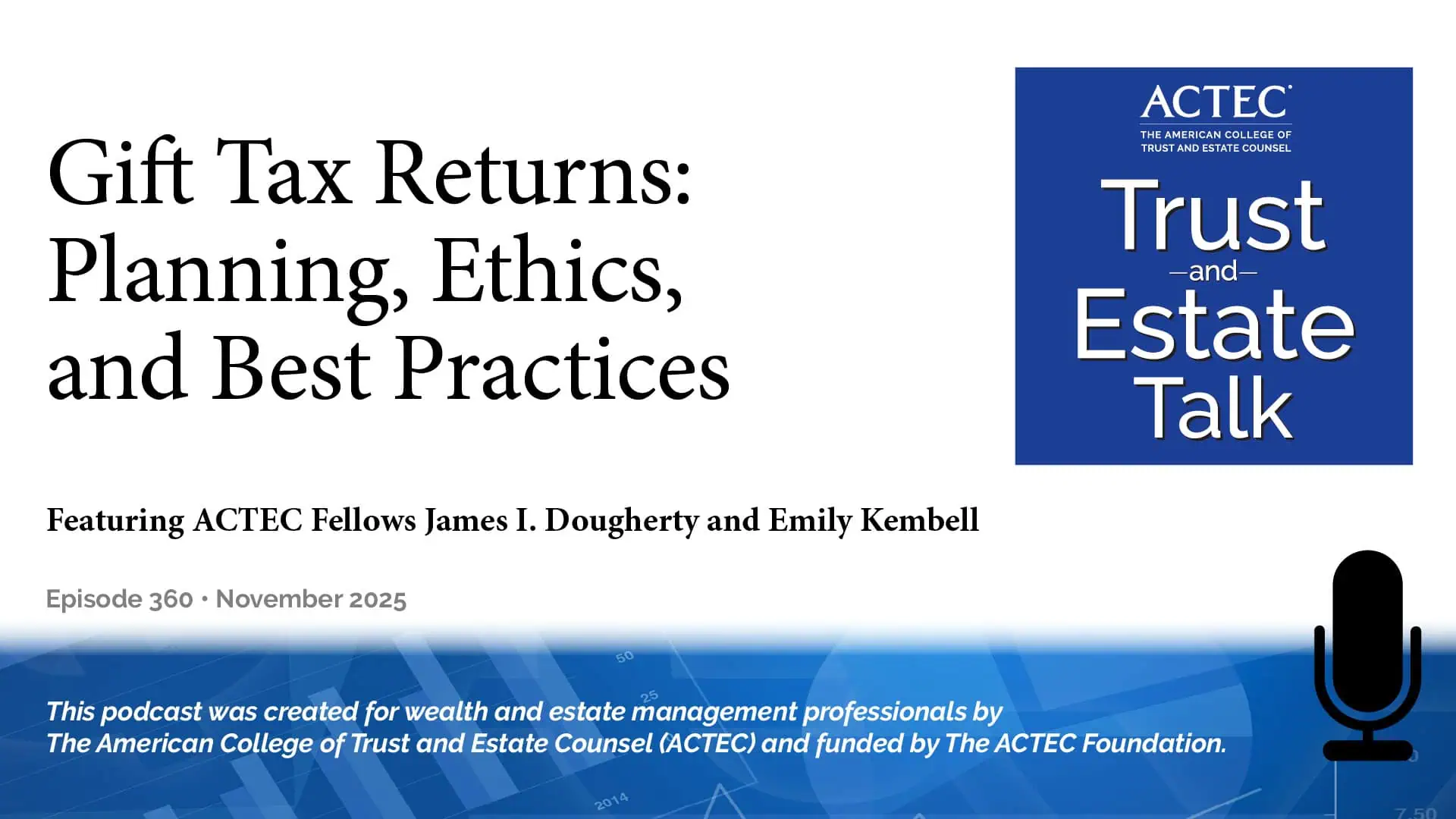
Gift Tax Returns: Planning, Ethics, and Best Practices
Learn about Form 709-NA, e-filing updates, gift splitting, digital assets, and disclosure rules in this ACTEC podcast on gift tax returns.
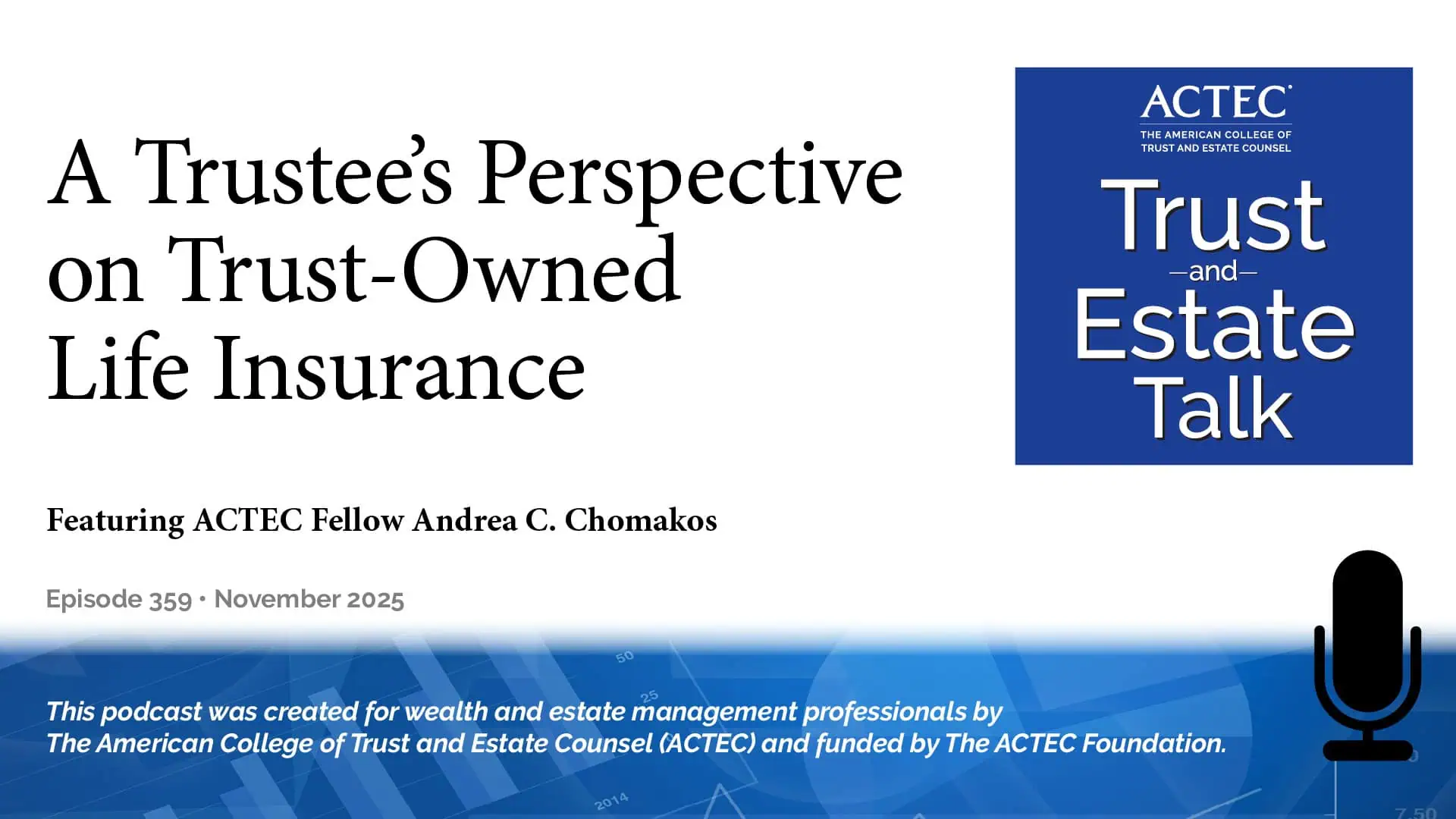
A Trustee’s Perspective on Trust-Owned Life Insurance
Learn key considerations for trustees managing Irrevocable Life Insurance Trusts (ILITs) and how to navigate grantor rules and withdrawal rights.

